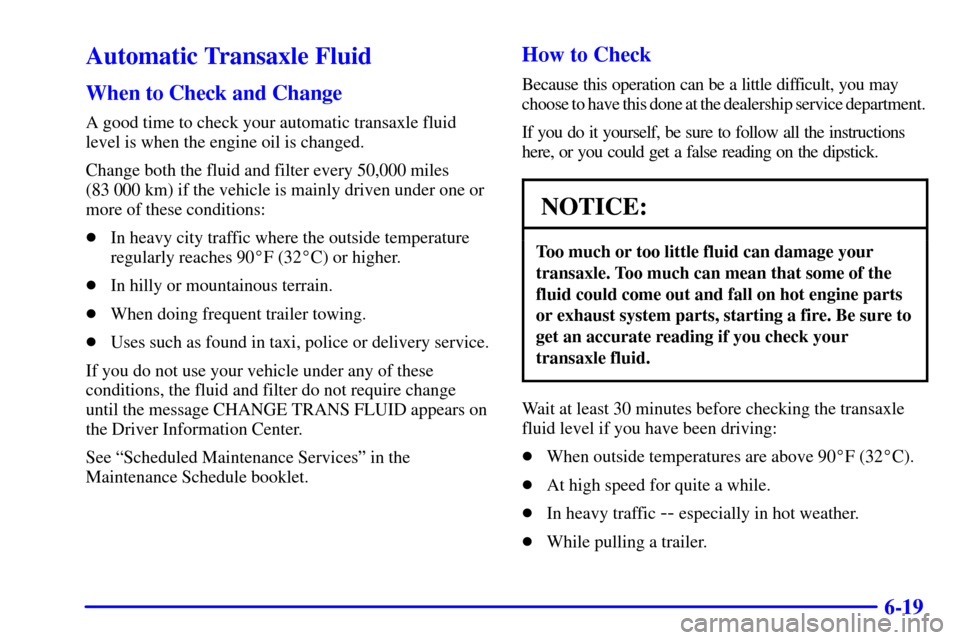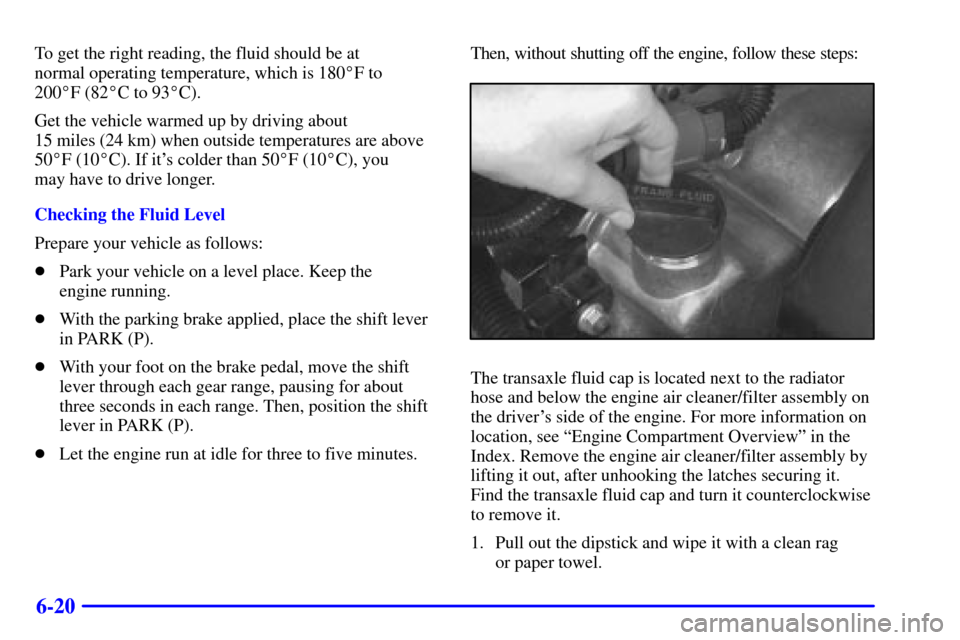Page 267 of 335
6-13 What Kind of Engine Oil to Use
Oils recommended for your vehicle can be identified by
looking for the starburst symbol.
This symbol indicates that the oil has been certified by
the American Petroleum Institute (API). Do not use any
oil which does not carry this starburst symbol.
If you change your own oil,
be sure you use oil that has
the starburst symbol on the
front of the oil container. If
you have your oil changed
for you, be sure the oil put
into your engine is
American Petroleum
Institute certified for
gasoline engines.
You should also use the proper viscosity oil for your
vehicle, as shown in the following chart:
Page 268 of 335

6-14
As in the chart shown previously, SAE 5W-30 is best for
your vehicle. However, you can use SAE 10W
-30 if it's
going to be 0�F (
-18�C) or above. These numbers on an
oil container show its viscosity, or thickness. Do not use
other viscosity oils, such as SAE 20W
-50.
NOTICE:
Use only engine oil with the American Petroleum
Institute Certified For Gasoline Engines
starburst symbol. Failure to use the
recommended oil can result in engine damage not
covered by your warranty.
GM Goodwrench� oil meets all the requirements for
your vehicle.
If you are in an area where the temperature falls below
-20�F (-29�C), consider using either an SAE 5W-30
synthetic oil or an SAE 0W
-30 oil. Both will provide
easier cold starting and better protection for your engine
at extremely low temperatures.
Engine Oil Additives
Don't add anything to your oil. The recommended oils
with the starburst symbol are all you will need for good
performance and engine protection.
When to Change Engine Oil
Your vehicle has a computer that lets you know when to
change your engine oil. This is not based on mileage, but
on engine revolutions and engine operating temperature.
When the computer has calculated that the oil needs
changing, the GM Oil Life System� will indicate that a
change is necessary. The mileage between oil and filter
changes will vary depending on how you drive your
vehicle
-- usually between 3,000 miles (5 000 km) and
10,000 miles (16 000 km) since your last oil and filter
change. Under severe conditions, the system may come on
before 3,000 miles (5 000 km). Never drive your vehicle
more than 10,000 miles (16 000 km) 12,500 miles
(20 000 km) or 12 months (whichever occurs first) without
an oil change.
The system won't detect dust in the oil. So, if you drive
in a dusty area, be sure to change your oil and filter
every 3,000 miles (5 000 km) or sooner. Remember to
reset the Oil Life Indicator whenever the oil is changed.
Page 269 of 335

6-15
How to Reset the Oil Life Indicator
1. After the oil has been changed, display the OIL LIFE
LEFT message by pressing the SKIP INFO button.
2. Then press and hold the NO INFO RESET button
until the display shows 100% ENGINE OIL LIFE.
This resets the oil life index.
The message will remain off until the next oil change
is needed. The percentage of oil life remaining may
be checked at any time by pressing the SKIP INFO
button several times until the OIL LIFE LEFT
message appears.
For more information on the Oil Life feature, see
ªOil Life Indicatorº in the Index.What to Do with Used Oil
Did you know that used engine oil contains certain
elements that may be unhealthy for your skin and could
even cause cancer? Don't let used oil stay on your skin
for very long. Clean your skin and nails with soap and
water, or a good hand cleaner. Wash or properly throw
away clothing or rags containing used engine oil. See
the manufacturer's warnings about the use and disposal
of oil products.
Used oil can be a real threat to the environment. If you
change your own oil, be sure to drain all free
-flowing oil
from the filter before disposal. Don't ever dispose of oil
by putting it in the trash, pouring it on the ground, into
sewers, or into streams or bodies of water. Instead,
recycle it by taking it to a place that collects used oil.
If you have a problem properly disposing of your used
oil, ask your dealer, a service station or a local recycling
center for help.
Page 270 of 335
6-16
Engine Air Cleaner/Filter
The engine air cleaner/filter is located next to the
windshield washer fluid reservoir on the driver's side of
the engine. For more information on location, see
ªEngine Compartment Overviewº in the Index. Be sure
the engine has cooled before following these steps to
replace the engine air cleaner/filter:
1. With a screwdriver,
loosen the air duct
clamp, which is located
at the mass airflow
sensor end of the
air duct.
2. Disconnect the air duct from the mass airflow sensor.
Page 271 of 335
6-17
3. Unhook both engine air cleaner/filter cover latches.
One latch is located near the radiator hose (not shown)
and the other latch is located next to the IAT sensor.
4. Pivot the air cleaner and air duct assembly toward
the front of the vehicle. Remove the cover.5. Take out the engine air cleaner/filter and remove any
loose debris that may be found in the base.
6. Install a new engine air cleaner/filter element. See
ªNormal Maintenance Replacement Partsº in the Index.
Page 272 of 335

6-18
Follow these steps to reinstall the engine air
cleaner/filter assembly:
1. Slide the lid into the slots in the front edge
of the base.
2. Pivot the cover and the air duct assembly
downward. Make sure that both latches are secure
and fully engaged.
3. Reinstall the clean air duct over the mass airflow
sensor. Make sure that the duct is secure around the
entire outer edge of the sensor.
4. Tighten the air duct clamp.
5. Reconnect the IAT sensor.
Refer to the Maintenance Schedule to determine when to
replace the air filter.
See ªScheduled Maintenance Servicesº in the
Maintenance Schedule booklet.
CAUTION:
Operating the engine with the air cleaner/filter
off can cause you or others to be burned. The air
cleaner not only cleans the air, it stops flame if
the engine backfires. If it isn't there, and the
engine backfires, you could be burned. Don't
drive with it off, and be careful working on the
engine with the air cleaner/filter off.
NOTICE:
If the air cleaner/filter is off, a backfire can cause
a damaging engine fire. And, dirt can easily
get into your engine, which will damage it.
Always have the air cleaner/filter in place when
you're driving.
Page 273 of 335

6-19
Automatic Transaxle Fluid
When to Check and Change
A good time to check your automatic transaxle fluid
level is when the engine oil is changed.
Change both the fluid and filter every 50,000 miles
(83 000 km) if the vehicle is mainly driven under one or
more of these conditions:
�In heavy city traffic where the outside temperature
regularly reaches 90�F (32�C) or higher.
�In hilly or mountainous terrain.
�When doing frequent trailer towing.
�Uses such as found in taxi, police or delivery service.
If you do not use your vehicle under any of these
conditions, the fluid and filter do not require change
until the message CHANGE TRANS FLUID appears on
the Driver Information Center.
See ªScheduled Maintenance Servicesº in the
Maintenance Schedule booklet.
How to Check
Because this operation can be a little difficult, you may
choose to have this done at the dealership service department.
If you do it yourself, be sure to follow all the instructions
here, or you could get a false reading on the dipstick.
NOTICE:
Too much or too little fluid can damage your
transaxle. Too much can mean that some of the
fluid could come out and fall on hot engine parts
or exhaust system parts, starting a fire. Be sure to
get an accurate reading if you check your
transaxle fluid.
Wait at least 30 minutes before checking the transaxle
fluid level if you have been driving:
�When outside temperatures are above 90�F (32�C).
�At high speed for quite a while.
�In heavy traffic
-- especially in hot weather.
�While pulling a trailer.
Page 274 of 335

6-20
To get the right reading, the fluid should be at
normal operating temperature, which is 180�F to
200�F (82�C to 93�C).
Get the vehicle warmed up by driving about
15 miles (24 km) when outside temperatures are above
50�F (10�C). If it's colder than 50�F (10�C), you
may have to drive longer.
Checking the Fluid Level
Prepare your vehicle as follows:
�Park your vehicle on a level place. Keep the
engine running.
�With the parking brake applied, place the shift lever
in PARK (P).
�With your foot on the brake pedal, move the shift
lever through each gear range, pausing for about
three seconds in each range. Then, position the shift
lever in PARK (P).
�Let the engine run at idle for three to five minutes.Then, without shutting off the engine, follow these steps:
The transaxle fluid cap is located next to the radiator
hose and below the engine air cleaner/filter assembly on
the driver's side of the engine. For more information on
location, see ªEngine Compartment Overviewº in the
Index. Remove the engine air cleaner/filter assembly by
lifting it out, after unhooking the latches securing it.
Find the transaxle fluid cap and turn it counterclockwise
to remove it.
1. Pull out the dipstick and wipe it with a clean rag
or paper towel.